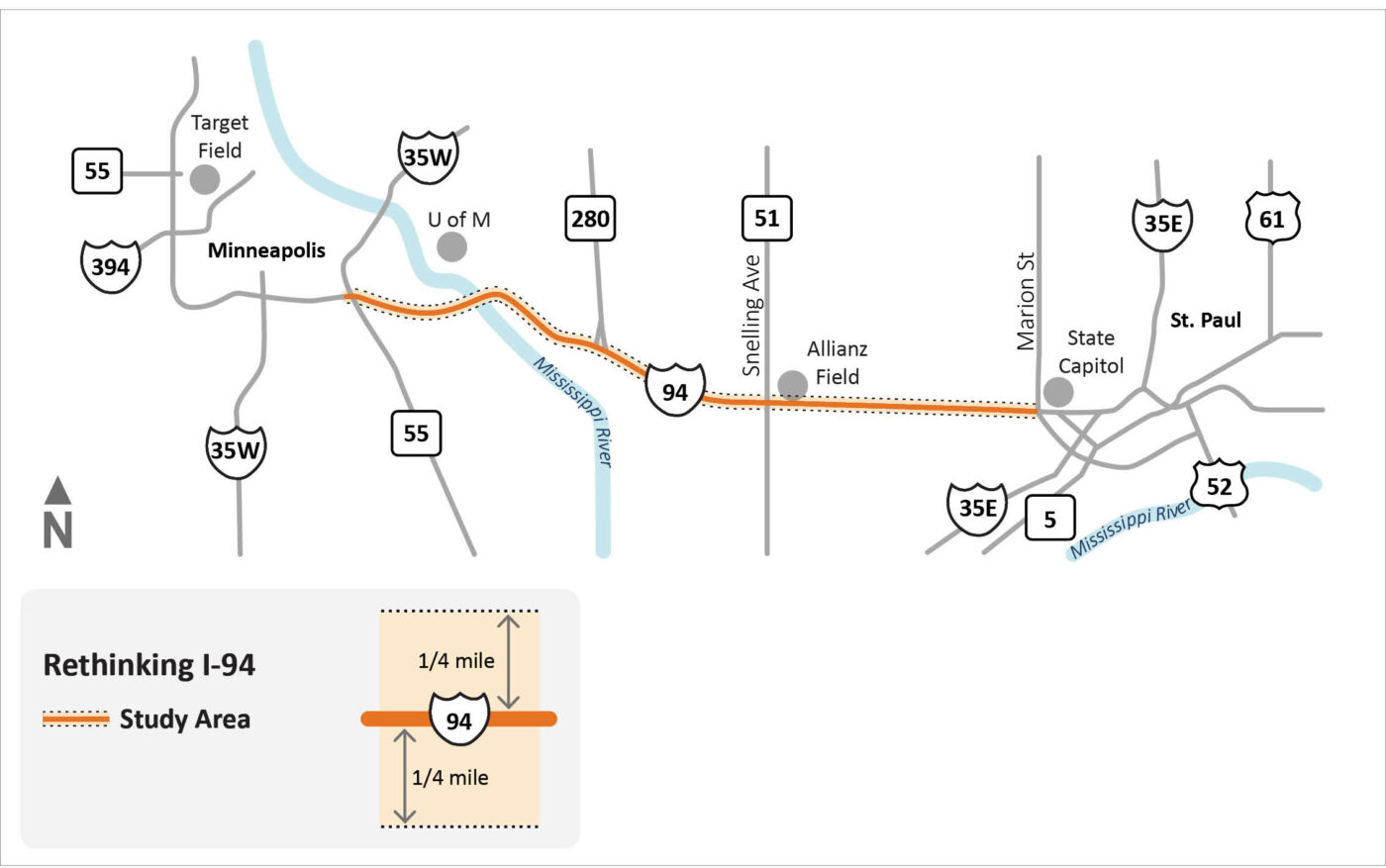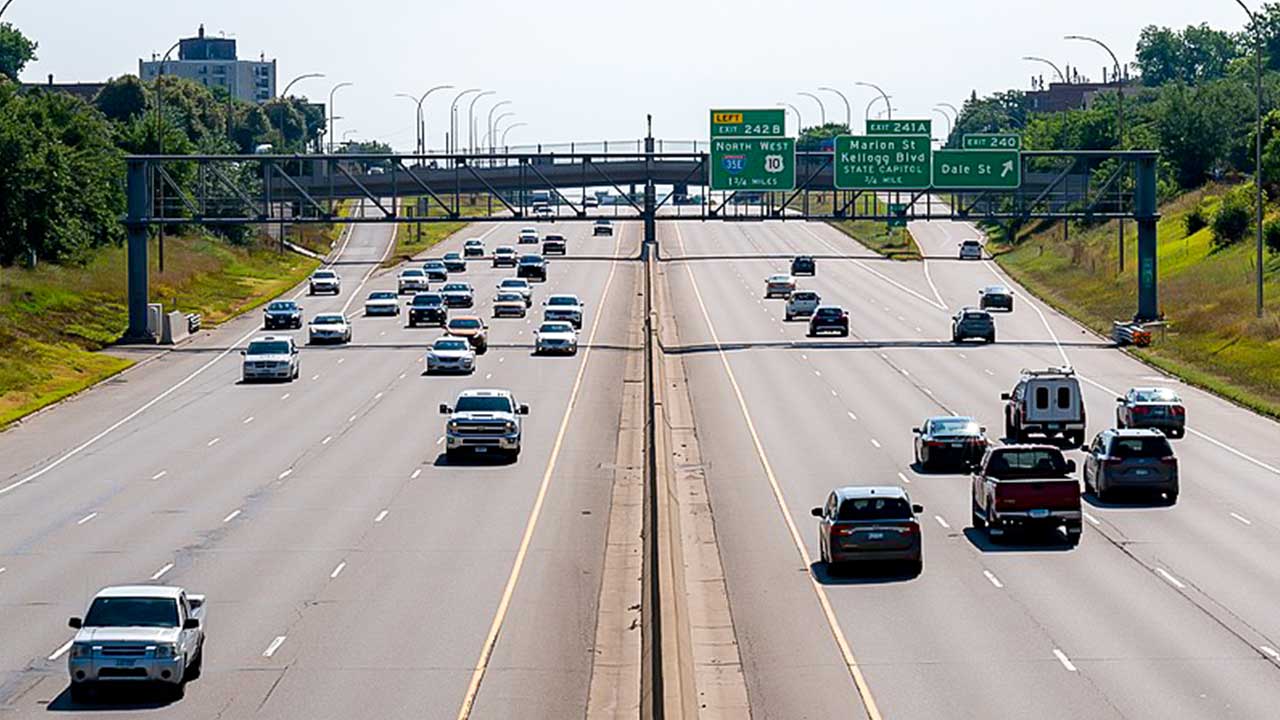Applying our new Driving Down Emissions Law to Rethinking I-94
Our new climate policy win is reshaping the future of transportation in Minnesota. What the law means for highway projects like Rethinking I-94.
In 2022, Colorado officials made headlines with a rare announcement. An agency known for building roads—the Colorado Department of Transportation—canceled a plan to widen Interstate 25, a major highway that runs through Denver. Just a few months later, a Denver regional planning body shifted $900 million from highway-widening projects to multimodal infrastructure, including faster buses and better bike lanes.
Could that happen in Minnesota? Thanks to our new transportation climate action law it’s almost a certainty.
In 2023, Minnesota passed a policy that took key aspects of Colorado’s landmark law to reduce climate pollution from big transportation projects and made it even broader. Move Minnesota was proud to develop and champion that nation-leading climate legislation with our elected allies and national partners. This year, Move Minnesota Action worked with Rep. Larry Kraft and Sen. Kelly Morrison to update our groundbreaking 2023 law to ensure even more projects undergo assessment to ensure they meet Minnesota’s 2050 goals to reduce per capita vehicle miles traveled by 20% and greenhouse gas emissions by 100%.
It’s not a simple process—and we break down all the details in this blog post. But here’s an example of what the policy will look like in real life, on a project that many of us are familiar with or following: Rethinking I-94.
What is Rethinking I-94?

In 2016, MnDOT began a process of “Rethinking I-94,” a process that will ultimately result in a reconstruction of the highway between downtown Minneapolis and downtown Saint Paul. The “rethinking” aspect involved early engagement with community groups and a pledge to do things differently from past highway processes. MnDOT’s timeline shows that the I-94 project will roll out over many years through a series of distinct phases. Right now, MnDOT is in a multi-year “scoping” phase and recently released six potential design concepts for the future reconstruction, which they call “alternatives,” ranging from the elimination of the highway to make a Twin Cities Boulevard-type landscape to a widening of the current highway to 10 lanes.
How would the 2023 version of the law impact I-94?

The 2023 version of the Driving Down Emissions law applies only to individual capacity expansion projects on the trunk highway system. For those types of projects, MnDOT has to make sure the project keeps us on track to meet our targets to reduce vehicle miles traveled (VMT) by 20% per capita and greenhouse gas emissions (GHG) by 100% by 2050. So, of the I-94 alternatives presented to the public earlier this year, only the Expanded Freeway alternative would be subject to the 2023 version of the law because all the other options maintain, redesign, or in some cases shrink I-94’s car capacity.
So, if MnDOT chose to pursue the Expanded Freeway alternative, we can safely assume the project would increase, not decrease, driving and pollution. While we do not know exactly how many additional car and truck trips would occur on I-94 in an expansion scenario, we can make an educated guess. While it varies over the corridor, current traffic on I-94 is in the vicinity of 164,000 trips per day on six to eight lanes. That’s between 20,000 and 27,000 trips per lane. If an additional two lanes (one in each direction) were added, we could reasonably expect another 30,000 to 40,000 car and truck trips per day. And more trips means more climate pollution.
That means, if MnDOT were to pursue that option they would also have to fund mitigation projects—like biking, walking, and transit investments. To meet the law’s requirements, MnDOT would have to add enough projects that decrease driving and emissions—say, funding a bus rapid transit route or many miles of protected bike infrastructure—to offset the impacts of the highway and make that package of projects consistent with our 2050 climate and driving targets.
So what would it look like to offset 40,000 car trips per day? Well, at its pre-pandemic peak in 2019, the METRO Green Line light rail train carried 44,000 trips each day. So offsetting an I-94 expansion might require an offset on the scale of a new urban train line!
That would significantly change the price tag on the highway expansion. For example, California officials calculated that a plan to spend $413 million on 16 miles of new toll roads will “induce” over 100 million additional VMT per year. To offset those projected increases, the agencies would have to allocate another $442 million for new transit, bus passes, housing densification, and bike lanes—more than doubling the cost of the project.
How will the 2024 version of the law impact I-94?

Our policy wins in 2024 expand the law’s reach and change how assessments and mitigation are done, broadening the number of projects included and increasing the positive impact across Minnesota.
First, the 2024 update requires that all trunk highway projects that are part of State Transportation Improvement Program (STIP —not just those that add lanes or capacity—must be assessed for consistency with Minnesota’s GHG and VMT reduction targets. The STIP is basically a list of all the big capital projects on which MnDOT and local jurisdictions plan to begin construction in the next four years.
So what does this mean for I-94? It means that, regardless of the alternative that moves forward, MnDOT must assess the long-term impacts and offset those impacts. This is significant because Minnesota’s goals are to reduce GHG emissions and VMT over time, not just halt their increase. So a project that maintains the status quo—like one of the I-94 options—will most likely fail to meet established targets. It is even possible that a project that is projected to reduce GHG emissions and VMT does not do so quite enough, and still needs additional mitigation.

For the I-94 project, Move Minnesota anticipates that the new, stronger law will result in a shift in how transportation modes are prioritized in the corridor. For example, Move Minnesota Action’s position is that, without widening the highway, the I-94 project should include fully dedicated transit lanes to provide express service between downtown Saint Paul and Minneapolis—and we are confident this kind of investment will help MnDOT meet the requirements of this new climate law.
Similarly, increased development, along with new pedestrian and bicycle facilities, on and along the corridor, whether as part of an at-grade option like the Twin Cities Boulevard proposal or a cap like the Reconnect Rondo proposal, would spur community connections, improve air quality, and increase walkability dramatically—again moving the I-94 project closer to the VMT and GHG reduction targets we need to meet for a safe and stable climate future while helping to address the harm I-94 has imposed on nearby neighborhoods since it was built.
What work remains
To fully realize the potential of the new Driving Down Emissions law, MnDOT will need to both curtail investments in polluting highway projects and increase investments in bike, walk, and transit projects. Thankfully, federal transportation funding, which is allocated through the Infrastructure Investment and Jobs Act (IIJA), provides highway funding flexibility—so states can redirect highway funds to sustainable multimodal projects. This means that, as Minnesota reduces investments in harmful highway projects, it can simultaneously increase available funding for climate-positive investments.
But Minnesota’s laws are different. Right now, the state’s transportation financing laws require more than $2 billion dollars of annual transportation revenue be spent only on highways. Without more flexibility in how this money can be spent, MnDOT will have a hard time finding adequate funding for mitigation projects—and, ironically, if MnDOT cannot secure money for mitigation projects, they cannot build the underlying highway project!
In both of the last two legislative sessions, Move Minnesota Action helped legislators draft bills to allow MnDOT to use highway funds for certain types of biking, walking, rolling, and transit projects—either projects near highways or projects needed to mitigate a highway project. While these bills did not pass, we’ll keep fighting to secure the funding flexibility necessary to fund mitigation projects like those MnDOT will likely need for I-94—and deliver the climate-friendly transportation investments Minnesota needs for a just, healthy, and sustainable future.

